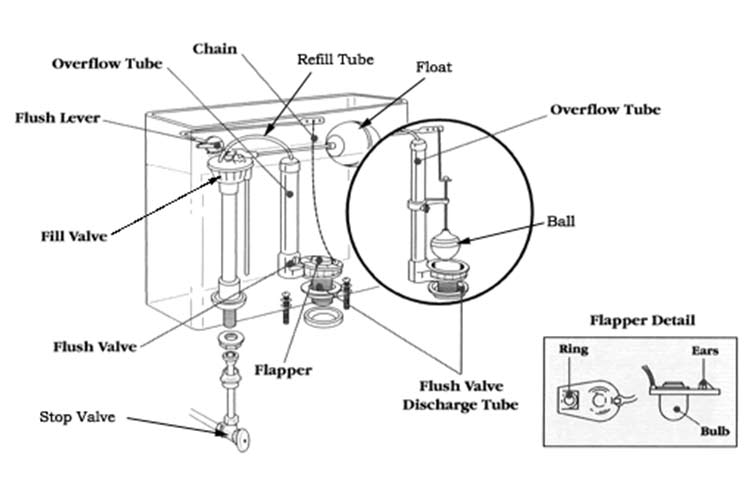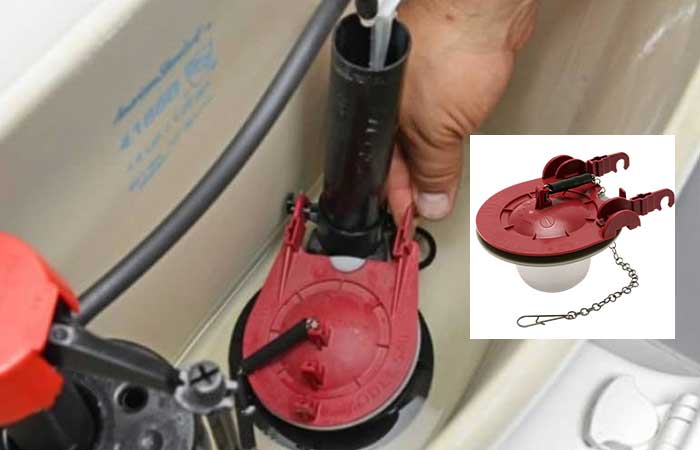Toilet Making Noise-After Flush, High-Pitched, Air, Hissing, when not in Use
The toilet can make noise for all sorts of reasons. There could be trapped air in the pipes, a faulty component like a flapper, a fill valve, or trip assembly, a clog in the drains, or a build-up of minerals in the tank.
Toilets making noise is an indication of a plumbing issue. A gurgling or bubbling sound coming from a vent means that it’s obstructed from releasing air. High pitched sounds could mean there’s something faulty in the tank. Hisses mean water is leaking or dripping in the tank or into the bowl.
There are many other noises you could hear such as air noises, ghost flushing, plus more. Following is a detailed discussion on how to identify the problem and possible fixes.
Toilet Making Noise after Flush
After you flush the toilet, the tank immediately starts the refill process which means water is getting into the tank, valves are opening and closing, the flapper is sealing, the handle is reverting to its normal 90-degree angle, among many other things.
If the toilet is making noise after the flush, listen to what type of noise it is.
Vibrating sounds coming from the wall indicate there’s a problem with your fill valve, precisely the diaphragm gasket in the fill valve is worn out and loose.
To confirm, just check inside the tank for the fill valve and watch it as you flush. If it vibrates, the gasket could be loose and needs to be tightened or replaced.
The fill valve could also be malfunctioning. This gives off a whistling sound to show the valve is slowly leaking. You have to adjust the valve by tightening it to the wall of the tank using a screwdriver. The sound should stop afterward. If the sound is still there, you may need to replace the entire thing.
Another prevalent sound you will hear is when the water runs constantly. This also means the valve is faulty and you have to replace it. You will find there are different types of floats; ball and arm float and the cylindrical float. Both of them are easy to replace.
There could be a whooshing sound the moment water has filled up the tank and has stopped getting into the tank. The sound of things moving inside the tank means there is a calcium build-up. The best thing to do is to clean the tank and remove all the residue.
Lastly, have you heard a loud thud in the tank about ten seconds after the flush? This is called a water hammer. The sound is also very common. It happens when the water supply into the tank is shut rapidly.
The momentum of the water causes it to slam forward and bang around against the sides of the pipe, and the inside of the fittings. This is what hammers and can also cause vibrations and chatter in the tank.
If the noise is disturbing to you, try reducing the flow of water into the tank by adjusting the speed at the supply valve. The valve can also be regulated to minimize the pressure of water refilling the tank.

Toilet Making High Pitched Noise
High-pitched sounds can be a squeak or a sharp whistling sound. You often hear this sound as the water refills into the tank.
This shouldn’t be a cause for concern. However, the squeak can also mean the ballcock or the float valve is sealing the bottom of the tank.
The ballcock will have such a sound when it has been used for some time, hence why people prefer to simply replace the entire thing rather than adjusting the existing ballcock mechanism. You could fit in the new ballcock yourself or have a professional plumber do the work for you.
Toilet Making Air Noises
Air noises sound like the train. It has an intermittent “ccchh” sound that can be quite irritating. First, check the flapper.

The flapper wears out as fast as the handle. This causes water to leak or run to the bowl every so often. The obvious solution would be to replace the flapper to get rid of the air noises.
Here’s a step by step guide on what to do;
- Open the lid to the tank and set it aside.
- Locate the flapper that should be at the bottom of the tank. It’s round and made from rubber. It sits on top of the drain hole.
- Flush the toilet and watch as the flapper is lifted by the flapper chain. Check to see the length of the chain if it’s too short or too long the flapper may not close properly hence water leaves the tank leaving those air noises.
- Repair the flapper by measuring the chain to approximately one to two inches long. You can also move the chains through the different holes in the lever rod. Select the best hole. Cut the remaining chain using a cutter or a pair of pliers.
- Check to see the flapper is now working well. If not, replace it.
- Make sure the water supply is shut because the moment you lift the flapper, more water will start to get into the tank.
- After you shut off the supply valve, flush the toilet to empty the tank.
- Detach the flapper from the bottom of the tank and install the new one. You can use a universal one if you’re not sure which one to choose.
- Open the supply valve and let water get into the tank. Confirm if the flapper is now working effectively.
Toilet Making Hissing Noises
Hissing in the toilet has been linked to a deteriorating flapper and the overflow tube running with water. If water fills and the fill valve doesn’t stop the water from continuing to run, it will go into the overflow tube.
You will have to adjust the water level in the tank to ensure the water doesn’t go into the overflow tube. It should remain half an inch below the tube. That should fix the hissing sounds.
The fill valve could also hiss to indicate debris stuck in the float cap. As the water passes the valve and through the float cup the debris obstructs it hence, it doesn’t fill the tank effectively. Think of it as low water pressure.
- Cut off the water supply and drain the water in the tank.
- Reach inside the tank to the float cup on the left side of the tank. Lift it with your right hand as you hold the shaft, keeping it held upright. Don’t drop the float cup nor turn the valve shaft as that may adjust water pressure into the tank.
- Place your left hand on the top of the valve cap and while placing your left-hand thumb on the side of the arm coming out of the top. Turn the cup and arm counter-clockwise to unlock.
- Lift off the cap from the valve and check for any debris. Run water through it and the seal; a rubber disc with a pin coming through.
- Once the valve has been cleaned. Reassemble the top of the valve by placing the arm of the cup next to the refill tube.
- Turn it clockwise to close. Let go and check for the water pressure and any noises coming from that area.
Toilet Making Loud Noises When not in Use
Loud noises coming from the toilet when you’re not in use could mean the toilet is ghost flushing.
This often happens when the flapper can’t seal the water in the tank so it’s letting out the water and it sounds like a flush.
The faulty flapper will keep on letting water into the toilet and the toilet will seem to magically flush on its own.
To determine whether or not the flapper really is the problem, add in some coloring in the tank water and leave the toilet unused.
When you come back and find coloring in your bowl, it means water is leaving the tank without getting flushed symbolizing a faulty flapper. As you know, the flapper is relatively cheap to purchase and install.
Therefore change up the old flapper and your problem should be tackled.
Toilet Makes Noise Randomly Every Few Minutes
When the toilet makes random noises now and then it’s out probably bubbles and gurgles. Gurgling noises indicate that there is negative pressure built up in the drains, pipes, or the sewer line.
The air pressure has formed air pockets that are obstructed from leaving the drain through the pipes, hence the bubbling and gurgling sounds.
As soon as air exits the drains, there will be bubbling in the toilet. This shows that there was a suction build-up in the drains which needs to be released.
The best way to solve this is by freeing the air either by pushing it back or further down the drainpipe through plunging and other methods.
The method you could use can further be determined by the location of the clog.
- Drain system – either close to the toilet or close to the sewer line. You could plunge or auger the toilet
- Vent stack – where the air gets released from (usually connected through the roof). You have to go to the roof to remove whatever may be obstructing the vent pipe.
General Tips to Prevent Noise from the Toilet
- Most of these noises come from worn-out toilet compartments such as the ballcock, flapper, and fill valve. Therefore, check to see that they’re working well and replace them if need be.
- Regularly clean the toilet to prevent clogs and build up that caused noise in the pipes and other gurgling sounds.
- Clean the vent pipes in the roof occasionally to avoid debris from entering.
- Clean the toilet system especially the yank to remove debris that could lower water pressure or restrict water from flowing freely into the tank.